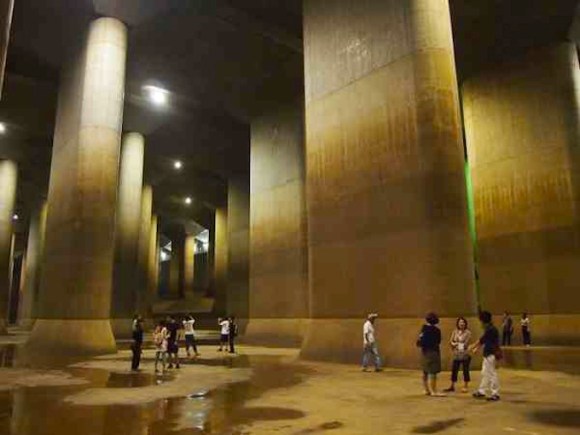
Deep beneath the ground, 19 miles north of Tokyo, lies a truly incredible feat of engineering. The G-Cans Project is the largest storm drain on earth, a colossal series of underground silos and tunnels, built to protect Tokyo from flooding during typhoon seasons. Its main hall (actually an enormous water tank) is held up by 59 columns each 25 metres high, and is known as the “Underground Temple”.
The facility is free to visit by guided tour, and the folks at Another Tokyo, a Japanese website introducing off-the-beaten-track places from around the country, recently went to check it out. This is what they found!
G-Cans (Shutoken Gaikaku Hōsuiro, or the Metropolitan Area Outer Underground Discharge Channel) is located in Kasukabe in eastern Saitama. The area is historically prone to flooding, and the G-Cans facility collects storm water from no less than five different rivers. It cost over 200 million yen (US$2 million) and took 17 years to construct, being completed in 2009. Due to its epic proportions and all-round underground spookiness, it has also been used as the setting for TV shows and commercials.
The facility is accessible via the underground exploration museum “Ryukyukan” (龍Q館). Tours are free, but must be booked in advance.
▼ Your ticket doubles as a souvenir postcard!
▼ This being Japan, there’s also a group stretch session before making the descent.
▼ Entry is via this unassuming door in the corner of the grounds.
And you’re in!
The facility is made up of five concrete containment silos, 65 by 32 metres, connected by 4 miles of tunnels. It’s this main water tank, the so-called “Underground Temple”, which is the real showstopper though. At a height of 25 m, and stretching for 177 m, the visiting people are dwarfed by the sheer scale of it.
Storm water flows into the facility through five cylindrical shafts like this one:
The ceiling is held up by 59 enormous pillars. Each weighing 500 tons, these also function as weights, preventing the tank, which is as large as a football pitch, from rising towards the surface.
Tours operate three times a day, but only on weekdays – in fact, only Tuesday to Friday! – so unless your office is as cool as ours is here at RocketNews24, you might have to call in sick.
There is some English information available on the official website; however, there are no English tours, and if you don’t understand Japanese, the organisers require that you bring an interpreter. We recommend that you phrase this request more along the lines of “Come see this incredible hall of wonders! I’ll shout you lunch!” rather than, “Hey, want to interpret for me while I go round a drain next Tuesday?”
Oh yeah, and access to the main surge tank is cancelled when it’s “in use”. Well, you wouldn’t want to be in there with all that water, would you?
All photos © Another Tokyo, and are reproduced here with their kind permission.
Source and images: Another Tokyo
Additional sources: Shutoken Gaikaku Hōsuiro Official Site, Atlas Obscura